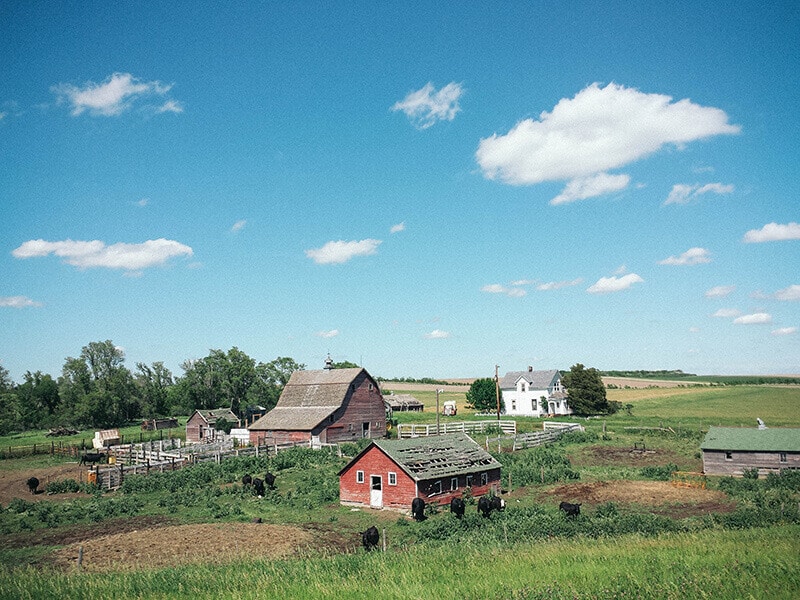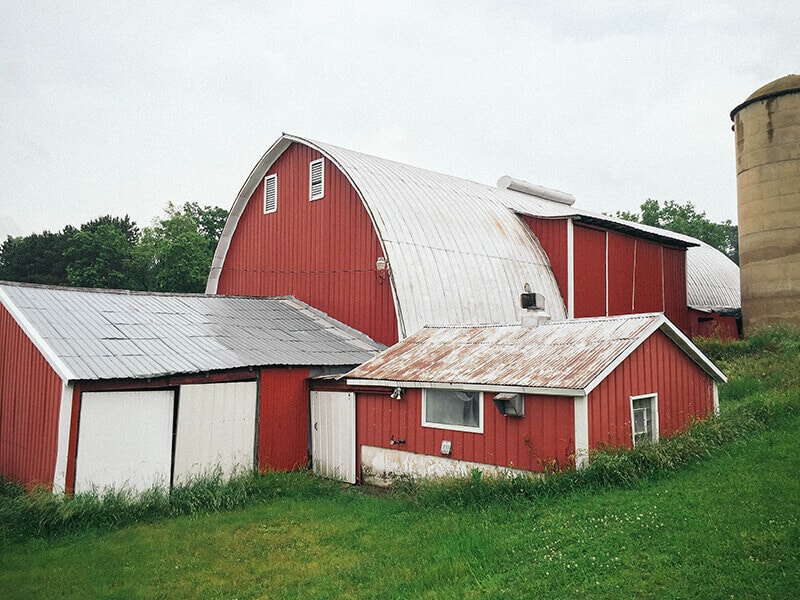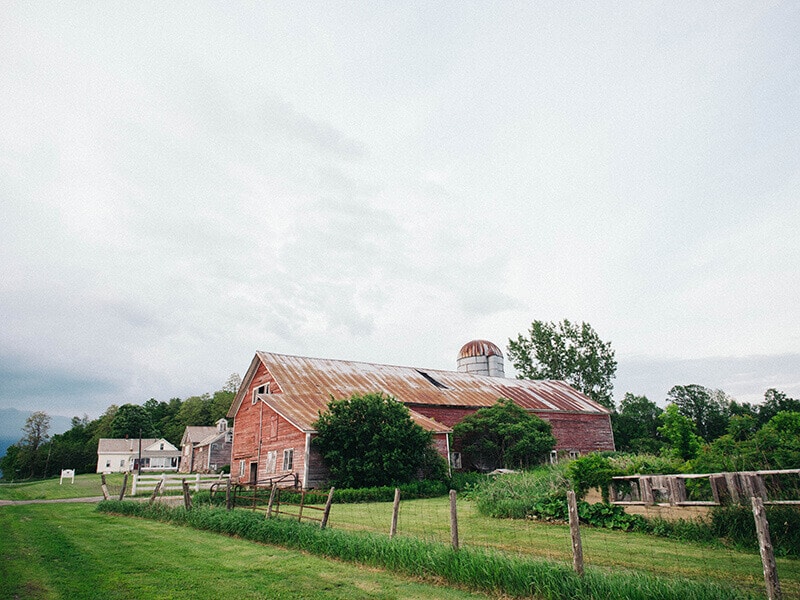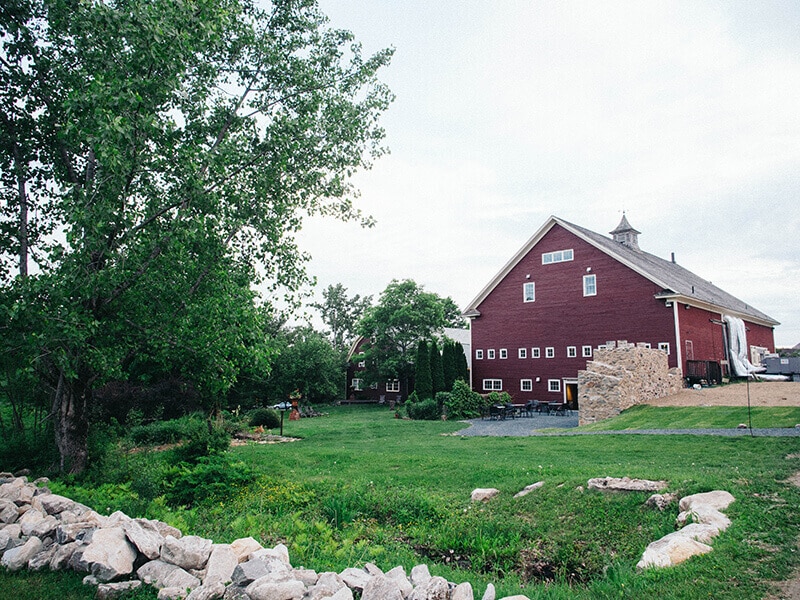Above: Western Pleasure Guest Ranch in Sandpoint, Idaho.
Maybe it’s the city girl in me, but I’ve always had a thing for classic red barns.
I find them so romantic. I love my barns old, creaky, and weather-worn. Every time we pass them out in the countryside, I always imagine myself as a muck boot-wearing farm gal… pitching hay, chasing piglets, grooming llamas, milking goats. I think the only thing that keeps me from setting up shop is the fact that I’m not an early riser at all. I’d end up milking my goats at noon and midnight!
While barns can be painted any color at the whimsy of the owner, we most often associate red with traditional wooden barns. The icon of rural Americana is found all over the country, most especially in the Northeast and Midwest. But how did the red barn come to be, and why do so many farmers still choose the color red?

Homestead in Northern Wyoming.
Let’s go back — way back — to the first American settlements in the 17th century. In the early days, barns weren’t painted at all, and they weren’t nearly as big as they are today. The pioneer barns were meticulously mapped and built from well-seasoned hand-hewn timber meant to withstand the test of time. Since commercial resources were non-existent, farmers were careful to place their barns with regard to the direction of the sun, wind, and water drainage — considerations that aided in naturally shielding their barns from the elements.
As farming practices and attitudes evolved, so did these age-old construction methods. Barns shifted from traditional timber frames to more efficient (and economical) truss-framed and plank-framed buildings, requiring farmers to seek new means to protect the wood from inclement weather.
They found that linseed oil, a yellowish-brown oil extracted from flaxseed, worked well as a preservative since it was water resistant. (The natural finish is still used today in a variety of applications.) By the 18th century, barns took on a burnt orange hue as farmers coated them with a mixture of linseed oil, skimmed milk, and lime, a combination that hardened quickly and resulted in a durable plastic-like film. Though the homemade wood sealant held up to rain and sun, it unfortunately didn’t protect against decay caused by fungi.
After realizing that rust was an effective agent against mold, farmers started adding ferric oxide (otherwise known as rusted iron) to the sealant. Ferric oxide was abundant and inexpensive, as it could be sourced from the soil. It also turned the sealant red, paving the way to the “barn red” we know today.

Barn in Western Wisconsin.
The 19th century saw the introduction of mass-produced paints with pigments, which proved to be more convenient and just as functional. “Barn red” remained popular as farmers began coating their barns in red paint — firstly as a throwback to tradition, and secondly, red paint was cheaper, plain and simple. (Why was it cheaper? If you’re the type that loves to decode the mysteries of the universe, Yonatan Zunger at Google has an answer for you. And it’s a real brain bender!) Red paint was also found to warm the barns better in winter, as the darker color absorbed more of the sun’s rays.

Barn in Bennington County, Vermont.
These days, barns come in a full range of colors (including my next favorite look, the whitewashed barn) and even materials, with most modern barns made of steel. But the traditional red barn is — and always will be — firmly rooted in Americana.

Gedney Farm in New Marlboro, Massachusetts.
All images taken on The CSA Cookbook Road Trip. Special thanks to Idaho Department of Commerce, Wisconsin Department of Tourism, Vermont Department of Tourism and Marketing, and Berkshire Visitors Bureau for their travel assistance.
















Kimberley Robertson liked this on Facebook.
RT @gardenbetty: Before paint was mass produced, there was rust. Why Are Barns Traditionally Red? https://t.co/8jgcGM94Qi #history https://…
Before paint was mass produced, there was rust. Why Are Barns Traditionally Red? https://t.co/8jgcGM94Qi #history https://t.co/tArO3NssR9
A little history lesson: Why Are Barns Traditionally Red? https://t.co/LrPARAa6xv @IdahoCommerce @TravelWI @VermontTourism @BerkshiresToday
Jaclyn Mahone liked this on Facebook.
Ruth Tomlinson liked this on Facebook.
RT @gardenbetty: In part, because red paint was cheaper back in the day! Why Are Barns Traditionally Red? https://t.co/FHA2P3mda9 #farm #hi…
Wonder why are barns are painted red? Here’s the answer: https://t.co/ISoEOdHTGe via @gardenbetty
The icon of rural Americana wasn’t always rosy. Why Are Barns Traditionally Red? https://t.co/swPxs9me1L #gardenchat https://t.co/DxJ4qQw4oS
RT @gardenbetty: In part, because red paint was cheaper back in the day! Why Are Barns Traditionally Red? https://t.co/FHA2P3mda9 #farm #hi…
Somewhere in Kentucky there is a sky blue barn. While the color is quite unique, it does make you think your eyes are tricking you on a beautiful clear day.
That sounds stunning! I adore that color. (My house actually has sky blue trim!)
In part, because red paint was cheaper back in the day! Why Are Barns Traditionally Red? https://t.co/FHA2P3mda9 #farm #history
Deanna Renee liked this on Facebook.
John Chard liked this on Facebook.
Natalie Alleblas liked this on Facebook.
Sarah Anne Meyer liked this on Facebook.
Nourish Schools liked this on Facebook.
Will Taylor liked this on Facebook.
So when there was a fire on the farm, the responders would hit the red building first, because that is where the most valuable possessions were located – the livestock!
Hint: Red paint didn’t exist back then. Why Are Barns Traditionally Red? https://t.co/UsjPwNtiCU #farm #history https://t.co/u4QS7H2Dju
Supplements Plus liked this on Facebook.
Sarah Breeding Schnute liked this on Facebook.
Laura Kassler Gaines liked this on Facebook.
Her Emerald Thumb liked this on Facebook.
Oscar Moreno liked this on Facebook.
I grew up on a Midwestern farm with a giant red barn. Many great memories of it. My mother photographed hundreds of barns in the 80s and 90s. They are definitely iconic.
I have a whole collection of barn photos too! Love them.
Great read!
Michael Martino liked this on Facebook.
Sarah Ann Barnard liked this on Facebook.
Cruehead ForLife liked this on Facebook.
Kate Bruni liked this on Facebook.
Robin McGlinchey liked this on Facebook.
Marie Bernard liked this on Facebook.
Interesting.
Lydia Ann liked this on Facebook.
Laurie Smith liked this on Facebook.
John Brunton liked this on Facebook.
Blogged on Garden Betty: Why Are Barns Traditionally Red? https://t.co/5oSQCYRrHy